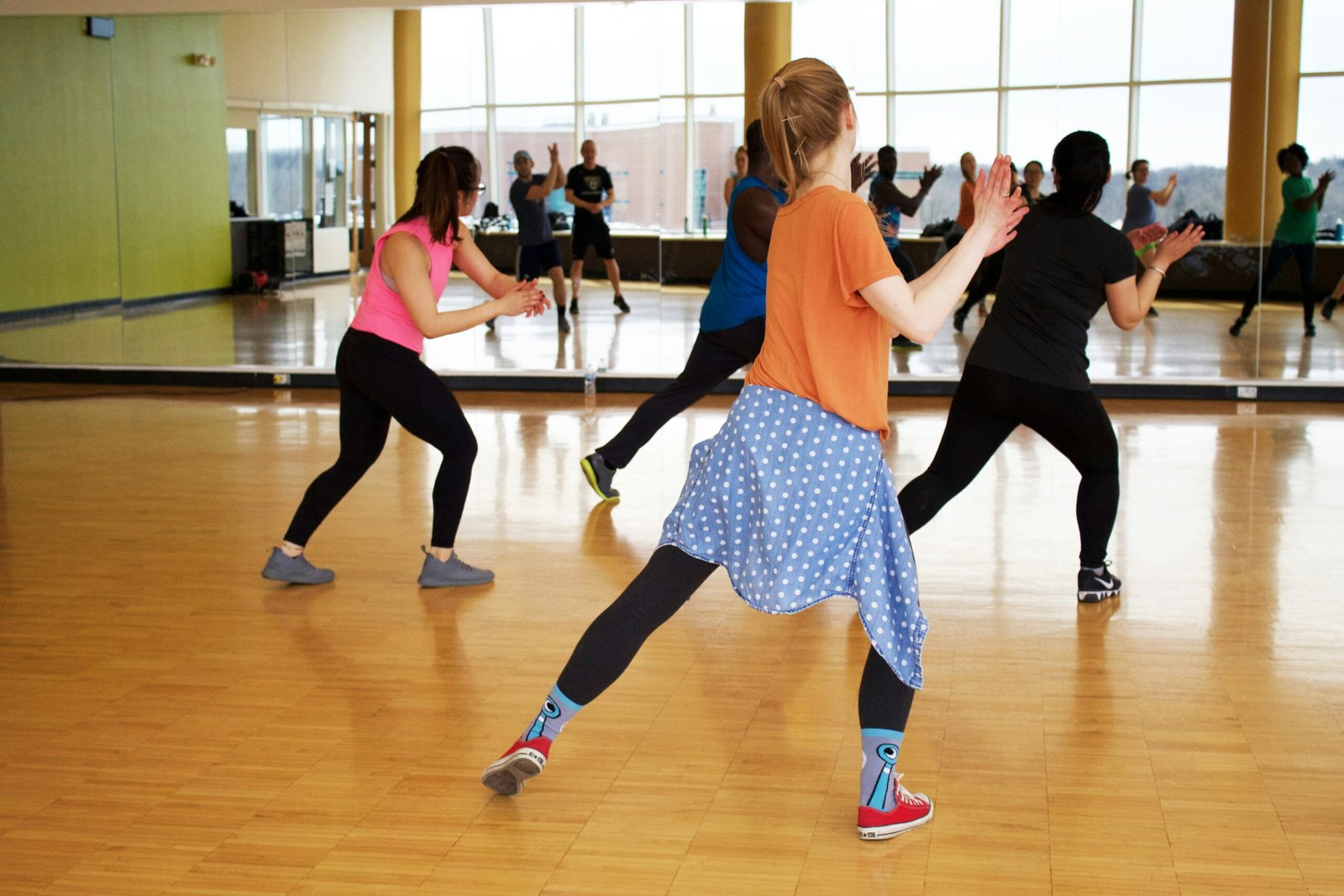
The duration of aerobic exercise depends on various factors, including your fitness level, goals, and overall health. The American Heart Association (AHA) recommends at least 150 minutes of moderate-intensity aerobic activity or 75 minutes of vigorous-intensity aerobic activity per week for adults. This translates to about 30 minutes of moderate-intensity exercise, such as brisk walking or cycling, on most days of the week.
However, it’s important to note that these guidelines are just a starting point. Some individuals may need more or less exercise based on their specific circumstances. For example, if you’re trying to lose weight or improve your cardiovascular health, you may need to increase the duration of your aerobic workouts.
It’s also worth mentioning that the intensity of your aerobic exercise plays a role in determining its duration. If you’re engaging in high-intensity activities like running or swimming laps, you may not need to exercise for as long to achieve the same benefits as lower-intensity workouts. In fact, research suggests that even short bursts of intense exercise can be highly effective in improving cardiovascular fitness and burning calories.
Additionally, incorporating variety into your aerobic exercise routine can help you avoid boredom and prevent overuse injuries. You can mix different types of activities, such as jogging, dancing, swimming, or cycling, to target different muscle groups and keep your workouts interesting.
Ultimately, the best duration for aerobic exercise is the one that fits into your schedule, allows you to maintain consistency, and keeps you motivated. It’s important to listen to your body and gradually increase the duration and intensity of your workouts over time. Consulting with a fitness professional or healthcare provider can also provide valuable guidance tailored to your specific needs and goals.
The General Guidelines
According to the American Heart Association (AHA), adults should aim for at least 150 minutes of moderate-intensity aerobic exercise or 75 minutes of vigorous-intensity aerobic exercise per week. This translates to approximately 30 minutes of moderate exercise on most days of the week or 25 minutes of vigorous exercise three days a week.
It’s important to note that these guidelines are based on the average healthy adult. If you have specific health conditions or concerns, it’s always best to consult with a healthcare professional before starting any exercise program.
When it comes to choosing the type of exercise, there are various options to consider. Aerobic exercises, such as walking, jogging, swimming, or cycling, are excellent choices for improving cardiovascular health. These activities increase your heart rate, making your heart and lungs work harder, thus improving their efficiency over time.
In addition to aerobic exercise, it’s also important to incorporate strength training into your exercise routine. Strength training exercises, such as lifting weights or using resistance bands, help build and maintain muscle mass. This is especially important as we age because muscle loss is a natural part of the aging process. By engaging in regular strength training, you can slow down this muscle loss and improve your overall strength and mobility.
Flexibility exercises are another crucial component of a well-rounded exercise routine. These exercises, such as stretching or yoga, help improve your range of motion and maintain joint flexibility. They can also help prevent injuries by keeping your muscles and joints supple and ready for activity.
While the AHA provides general guidelines for exercise, it’s important to listen to your body and adjust your routine accordingly. If you’re just starting out, it’s okay to begin with shorter durations or lower intensities and gradually increase them over time. It’s also important to warm up before exercising and cool down afterward to prevent injuries and allow your body to recover.
Remember, exercise should be enjoyable and sustainable. Find activities that you genuinely enjoy and that fit into your lifestyle. Whether it’s dancing, hiking, or playing a sport, the key is to stay active and make exercise a regular part of your routine. By doing so, you’ll not only reap the physical benefits but also experience improved mood, increased energy levels, and better overall well-being.
Factors to Consider
While the general guidelines provide a good starting point, there are several factors to consider when determining the ideal duration of your aerobic exercise sessions:
1. Fitness Level
Your current fitness level plays a significant role in determining how long you should engage in aerobic exercise. Beginners may need to start with shorter sessions and gradually increase the duration as their fitness improves. On the other hand, individuals who are already physically fit may require longer sessions to challenge their bodies and continue making progress.
2. Exercise Intensity
The intensity of your aerobic exercise also affects the ideal duration. Moderate-intensity exercise, such as brisk walking or cycling, can be sustained for longer periods compared to high-intensity activities like running or interval training. If you’re engaging in vigorous-intensity exercise, shorter durations may be more appropriate to avoid overexertion and reduce the risk of injury.
3. Goals and Preferences
Your personal goals and preferences should also be taken into account. If your primary goal is weight loss, longer aerobic sessions may be beneficial. However, if you’re short on time or prefer shorter bursts of activity, high-intensity interval training (HIIT) can be a time-efficient option. HIIT involves alternating short periods of intense exercise with brief recovery periods.
4. Time Availability
Another factor to consider is the amount of time you have available for exercise. If you have a busy schedule, shorter aerobic sessions may be more practical. On the other hand, if you have more flexibility in your schedule, longer sessions may be feasible.
5. Overall Health and Physical Condition
Your overall health and physical condition should also be taken into consideration. If you have any underlying health conditions or injuries, it’s important to consult with a healthcare professional before determining the duration of your aerobic exercise sessions. They can provide guidance based on your specific needs and limitations.
6. Training Program
If you’re following a specific training program, such as preparing for a marathon or participating in a sports event, the duration of your aerobic exercise sessions may be outlined in the program. It’s important to adhere to the program guidelines to ensure you’re adequately preparing your body for the specific event or goal.
By considering these factors, you can determine the ideal duration of your aerobic exercise sessions that aligns with your goals, preferences, and overall physical well-being.
Listen to Your Body
While guidelines and factors provide useful insights, it’s crucial to listen to your body and adjust your exercise duration accordingly. Pay attention to how you feel during and after your workouts. If you’re consistently feeling fatigued or experiencing pain, it may be a sign that you’re overdoing it.
Remember, consistency is key when it comes to aerobic exercise. It’s better to engage in regular, shorter sessions than to push yourself too hard and risk burnout or injury. Gradually increase the duration and intensity of your workouts as your fitness improves.
Listening to your body means being in tune with its signals and responding appropriately. This requires mindfulness and self-awareness. When you exercise, your body communicates with you through various sensations and feedback. It’s important to pay attention to these cues and make adjustments as needed.
For example, if you notice that your breathing becomes labored and you’re struggling to maintain proper form, it might be a sign that you’re pushing yourself too hard. In this case, it’s wise to take a break, catch your breath, and then resume at a more comfortable pace.
Similarly, if you experience persistent muscle soreness or joint pain after a workout, it’s a sign that you may have overexerted yourself. Ignoring these signals and continuing to push through the pain can lead to more serious injuries and setbacks in your fitness journey.
On the other hand, if you find that your workouts are becoming too easy and you’re not feeling challenged anymore, it may be time to increase the duration or intensity of your exercises. This will help you continue to progress and avoid plateauing in your fitness goals.
Remember that everyone’s body is different, and what works for one person may not work for another. It’s important to listen to your own body’s unique needs and limitations. This means being honest with yourself and making adjustments based on your own comfort level and capabilities.
Ultimately, the goal is to find a balance between pushing yourself enough to see progress and avoiding pushing yourself too hard and risking injury. By listening to your body and being mindful of its signals, you can create a sustainable and effective exercise routine that supports your overall health and well-being.
Additional Tips
Here are a few additional tips to help you make the most of your aerobic exercise sessions:
1. Warm Up and Cool Down
Always start your aerobic workouts with a proper warm-up to prepare your body for exercise. This can include dynamic stretches, light cardio, or mobility exercises. Similarly, end your sessions with a cool-down period to gradually lower your heart rate and allow your body to recover.
2. Mix Up Your Routine
Keep your aerobic workouts interesting and prevent boredom by incorporating a variety of activities. This can include walking, jogging, swimming, cycling, dancing, or using cardio machines at the gym. Mixing up your routine also helps target different muscle groups and prevents overuse injuries.
3. Monitor Your Heart Rate
Monitoring your heart rate during aerobic exercise can provide valuable insights into the intensity of your workout. You can use a heart rate monitor or simply check your pulse manually. Aim to maintain a target heart rate range based on your age and fitness level. This will ensure that you’re working at an appropriate intensity.
4. Stay Hydrated
Proper hydration is essential for optimal performance and recovery. Drink water before, during, and after your aerobic workouts to stay hydrated. The exact amount of water you need will depend on factors such as your body weight, exercise intensity, and environmental conditions.
5. Rest and Recovery
Allow your body enough time to rest and recover between aerobic workouts. This is when the body repairs and strengthens itself. Aim for at least one or two days of rest each week to prevent overtraining and reduce the risk of injuries.
In addition to these tips, it’s important to pay attention to your form and technique during aerobic exercises. Proper form not only maximizes the effectiveness of your workouts but also reduces the risk of injury. If you’re new to aerobic exercise or unsure about your form, consider working with a qualified fitness professional who can guide you and provide feedback.
Another aspect to consider is the duration and frequency of your aerobic workouts. While it’s important to challenge yourself, it’s equally important to listen to your body and avoid overdoing it. Gradually increase the duration and intensity of your workouts over time to avoid burnout and allow your body to adapt.
When it comes to choosing the right aerobic exercises for you, consider your personal preferences, fitness goals, and any underlying health conditions. If you have any concerns or medical conditions, consult with a healthcare professional before starting a new exercise program.
Lastly, don’t forget to enjoy the process! Aerobic exercise is not only beneficial for your physical health but also for your mental well-being. Find activities that you genuinely enjoy and make them a regular part of your routine. Whether it’s dancing to your favorite music, exploring nature on a hike, or joining a group fitness class, find what brings you joy and keep moving!




